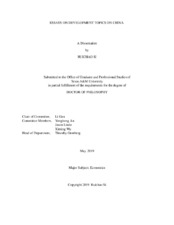| dc.description.abstract | China has experienced fast development in the past decades. This dissertation studies several topics related to the recent development issues in rural and urban China. Section 2 studies China’s urbanization since the 2010s. In Section 3, I study the factor utilization in the agricultural sector in rural China while Section 4 studies the education investment and human capital accumulation for Chinese high school students. First, urbanization is a key path for countries to achievement development. China’s rapid economic growth over the past 40 years has been accompanied by an increasingly rapid rate of urbanization, from less than 20% in the late 1970s to almost 60% in the 2010s. In addition to natural population growth, rural-urban migration is generally believed to be a dominant driving force of the urbanization process. In Section 2, however, I demonstrate that a large share of urban population growth comes from community reclassification. I find that these in situ migrants (from communities which were reclassified from rural to urban) accounted for almost 35% of total urban population growth in the first half of the 2010s. Households in reclassified communities share similar characteristics with rural village communities, particularly in their ownership of housing. Furthermore, I provide evidence that the scale of in situ migrants is significantly related to residential land supply at the prefecture level. Moreover, the development of agricultural sector is also of great significance for a highly populous developing country like China. Secure property rights are key determinants of economic development. In developing countries where agricultural activities still play a major role, property rights in rural land become critical. In Section 3, I evaluate the impact of land certification program in rural China. Employing a panel dataset of over 1,000 villages all across the country and exploiting the variations in years of certification, I find that less agricultural land is left idle in villages where the land has been certified. This result is robust to various checks including using a more comparable control group from the propensity score matching method. Such effects are more significant in high-income villages or those from provinces in which the economy highly depends on the agricultural sector. Additionally, I document evidence that the effect of land certification program on improving land utilization might be a result that households with land being certified are more likely to transfer their cultivated land to new agricultural business entities that might possibly increase land utilization. Finally, the development of human capital and investment in education play a fundamental role for long-run development. Household investment in children’s education is among one of the largest shares of inter-generational investments. In Section 4, I study whether changes in opportunity costs of re-taking a high-stake exam caused by an exogenous policy result in different levels of household investment in children’s education. Specifically, I employ the curriculum reform of senior high school in mainland China in 2000s and demonstrate that students in the last cohort using old curriculum are faced with a more difficult situation in terms of re-taking College Entrance Examination since their re-taking costs are much higher due to the curriculum switch. Using province-level administrative data, I confirm the pattern that the adoption of the new curriculum significantly reduces the number of re-takers at its introduction year. I then study the effect of this changing opportunity cost on household investments in senior high school students. Empirical results indicate that households with students facing higher re-taking opportunity costs are more likely to have equipments and inputs that help improve their learning efficiency. However, I do not find any long-term effect after students are enrolled into college. | en |


